It’s not exactly the sort of car likely to strike fear in the hearts of seasoned criminals, but the Los Angeles Police Department has added a new tool to its fleet of cruisers, a modified version of the BMW i3 battery-electric vehicle.
Decked out in the LAPD’s familiar black-and-white, with the motto, “to protect and to serve,” emblazoned on its doors, the pint-sized EV will be put on patrol in downtown L.A. as part of the city’s efforts to green its government fleet.
The i3 joins an assortment of unusual police cars cruising streets around the world, a list that includes supercars like the Lamborghini Huracan and Ferrari FF, as well as a hearse. Some are used for high-speed freeway pursuits, but others serve as part of community campaigns emphasizing safety or simply to put a more friendly face on the local constabulary.
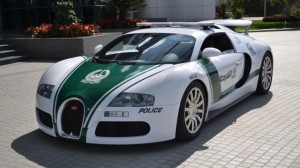
The Dubai Police Department recently added a new $1.6 million Bugatti Veyron to its fleet of supercars.
“Today, we take another step toward becoming the most sustainable city in America,” L.A. Mayor Eric Garcetti said during a ceremony marking the debut of the LAPD’s BMW i3. “This year, Los Angeles will become home to the largest city-owned fleet of pure battery electric vehicles anywhere in the country, and we will save taxpayer dollars along the way.”
All told, various Los Angeles government fleets – including police, fire and other departments, will lease 160 battery-electric vehicles, as well as another 128 plug-in hybrids.
(Police around the country cracking down on left-lane hogs. Click Here for the story.)
The i3 is one of two models offered by the Bavarian maker’s new sub-brand BMW i. It features a lightweight carbon fiber body and is powered by a small electric motor drawing power from a lithium-ion battery pack.
“The i3 is a brilliant fit with the technology-driven research philosophy of the LAPD,” said Christine Fleischer, manager for BMW plug-in cars in the U.S. “This will be a valuable learning experience for both BMW and the Department.”
The LAPD has also been experimenting with electric motorcycles, though the limited range they offer has made it a challenge to use them as a replacement for conventional, gasoline-powered models.
Los Angeles is by no means the only place where police have been looking to go green. The Police Service of Northern Ireland tried out a Vauxhall Ampera plug-in hybrid several years ago to see if the technology could prove effective.
Part of the challenge is the limited range that electric power offers – something that can be overcome with plug-ins that can fire up their gas engines when their batteries run down. But police cruisers can get beaten up pretty badly, and it’s far from certain they can stand up to patrol duties on a day-to-day basis.
Besides, they typically can’t deliver the power needed for high-speed pursuits, which is why some police departments have been opting for more sporty alternatives. A number of European forces have turned to brands like Alfa Romeo and Mercedes-Benz. AC Schnitzer, a performance “tuner,” has modified the BMW 428i coupe for use on the German Autobahn.
The oil-rich emirate of Dubai has taken things to extremes. It has built up a fleet of supercars, including a four-seat Ferrari FF which can hit 208 mph thanks to its 650-horsepower V-12. If that’s not fast enough, there’s also a $1.6 million Bugatti Veyron that can reach 60 in a mere 2.5 seconds, on its way to a top speed of 270 mph.
Dubai also has a McLaren MP4-12C, a Bentley Continental GT, a Mercedes SLS and a Lamborghini Aventador in its fleet.
While Italian authorities don’t have quite as rich a fleet, they did add a 202 mph Lamborghini Huracan to patrol their autostrada – the equivalent of America’s Interstate highways — in spring 2014.
(Teen drivers pose risk to everyone on the road, says new study. Click Here for the story.)
Australia is notoriously intolerant of speeds, and authorities in New South Wales have a Porsche 911 that can hit 60 in barely 4 seconds, enough to catch all but the fastest miscreants. But the sports car is largely used for community events, rather than patrol duties.
The Vancouver, British Columbia police department has several unusual cars in its fleet, including a Honda Civic Si-R. Among other things, they’re used to demonstrate what modifications are – and aren’t – legal for street racers to make.
The constabulary in Avon and Somerset, England picked up a skeletal Ariel Atom, with its modified, 350-hp supercharged Honda motor, to promote the department’s Safer Rider campaign.
And perhaps one of the oddest vehicles authorities are driving can be found in Toronto. As part of a new campaign to emphasizing the dangers of texting while driving, the city’s police force deputized a hearse.
Over the years, police forces around the world have tried out a variety of other vehicles meant to deal with local challenges: SUVs to deal with hostile and desert environments, as well as vehicles modified with tracks to help crawl through deep snow.
(California is nirvana for car thieves. Click Herefor the story.)

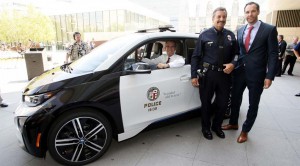
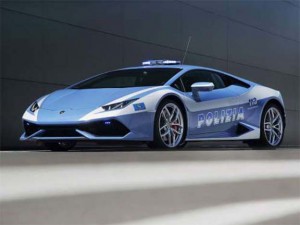
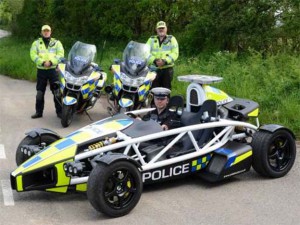
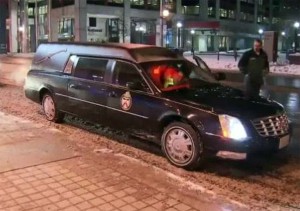
Wait until the LA gangs flip these i3 toys over on their roof and the media shows it on TV. Then everyone will be “green”. Can you imagine chasing a perp with one of these i3’s and the batteries going dead after 15 minutes of pursuit? The criminals will be laughing all the way home.
Unfortunately most distracted drivers are unconcerned about crashing and dying or killing innocent bystanders. Apparently talking on their cellphone is literally worth dying for.